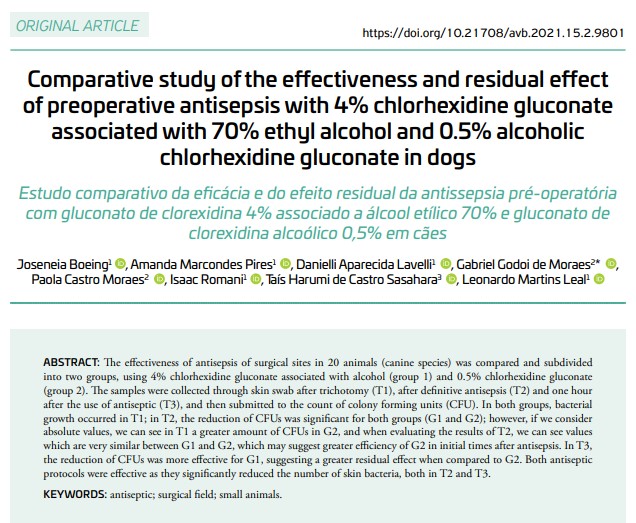Comparative study of the effectiveness and residual effect of preoperative antisepsis with 4% chlorhexidine gluconate associated with 70% ethyl alcohol and 0.5% alcoholic chlorhexidine gluconate in dogs
DOI:
https://doi.org/10.21708/avb.2021.15.2.9801Abstract
The effectiveness of antisepsis of surgical sites in 20 animals (canine species) was compared and subdivided into two groups, using 4% chlorhexidine gluconate associated with alcohol (group 1) and 0.5% chlorhexidine gluconate (group 2). The samples were collected through skin swab after trichotomy (T1), after definitive antisepsis (T2) and one hour after the use of antiseptic (T3), and then submitted to the count of colony forming units (CFU). In both groups, bacterial growth occurred in T1; in T2, the reduction of CFUs was significant for both groups (G1 and G2); however, if we consider absolute values, we can see in T1 a greater amount of CFUs in G2, and when evaluating the results of T2, we can see values which are very similar between G1 and G2, which may suggest greater efficiency of G2 in initial times after antisepsis. In T3, the reduction of CFUs was more effective for G1, suggesting a greater residual effect when compared to G2. Both antiseptic protocols were effective as they significantly reduced the number of skin bacteria, both in T2 and T3.
Downloads

Downloads
Published
Issue
Section
License
Autores que publicam na Acta Veterinaria Brasilica concordam com os seguintes termos: a) Autores mantém os direitos autorais e concedem à revista o direito de primeira publicação, com o trabalho simultaneamente licenciado sob a Licença Creative Commons Attribution que permite o compartilhamento do trabalho com reconhecimento da autoria e publicação inicial nesta revista. b) Autores têm autorização para assumir contratos adicionais separadamente, para distribuição não-exclusiva da versão do trabalho publicada nesta revista (ex.: publicar em repositório institucional ou como capítulo de livro), com reconhecimento de autoria e publicação inicial nesta revista. c) Autores têm permissão e são estimulados a publicar e distribuir seu trabalho online (ex.: em repositórios institucionais ou na sua página pessoal) a qualquer ponto antes ou durante o processo editorial, já que isso pode gerar alterações produtivas, bem como aumentar o impacto e a citação do trabalho publicado (Veja O Efeito do Acesso Livre).


 Esta obra está licenciada com uma Licença
Esta obra está licenciada com uma Licença 